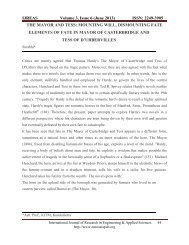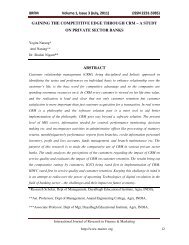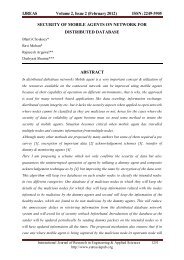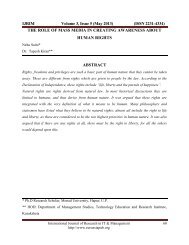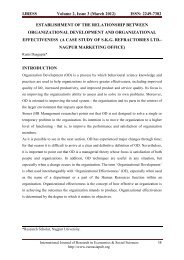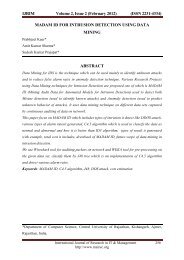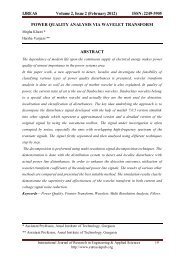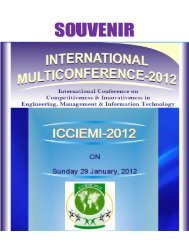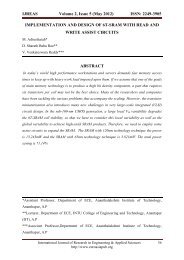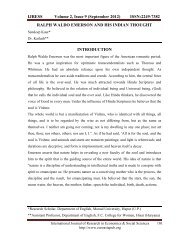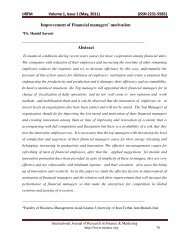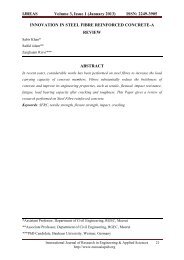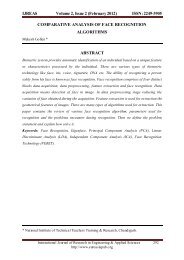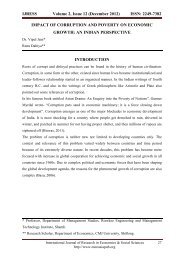WHAT DOES ONE LOOK FOR IN A JOB? - Euroasiapub.org
WHAT DOES ONE LOOK FOR IN A JOB? - Euroasiapub.org
WHAT DOES ONE LOOK FOR IN A JOB? - Euroasiapub.org
You also want an ePaper? Increase the reach of your titles
YUMPU automatically turns print PDFs into web optimized ePapers that Google loves.
IJRIM Volume 1, Issue 1 (May, 2011) ISSN 2231-4334<br />
<strong>WHAT</strong> <strong>DOES</strong> <strong>ONE</strong> <strong>LOOK</strong> <strong>FOR</strong> <strong>IN</strong> A <strong>JOB</strong><br />
(Critical Analysis of Motivators and Hygiene Factors with special reference<br />
to employees of Private and Public Sector Banks in India)<br />
Prof S.R Badrinarayan*<br />
Prof Preeti Tilekar**<br />
ABSTRACT<br />
The Research has focussed on studying & identifying critical motivators & hygiene factors in<br />
a job as perceived by employees from banking sector in India. The instrument contains 14<br />
items, seven related to intrinsic & 7 related to extrinsic motivation as described by Herzberg.<br />
Validity of the instrument has been measured with the help of Factor Analysis using a Two<br />
Factor Solution. The ranks given are added for factors. The Lower the Score, the higher is<br />
the value given to the concerned motivational factors. Also the same is validated through<br />
measuring the mean values for all the 14 items for the group of respondents. This has further<br />
helped the researcher in identifying intrinsic & extrinsic aspects having significant factor<br />
loadings.<br />
* Asst. Professor, Sinhgad Institute for Management & Computer Applications, Pune<br />
** Asst. Professor, Sinhgad Institute for Management & Computer Applications, Pune<br />
International Journal of Research in IT & Management<br />
http://www.mairec <strong>org</strong> 39
IJRIM Volume 1, Issue 1 (May, 2011) ISSN 2231-4334<br />
Conceptual Framework<br />
Define<br />
Measure<br />
Literature<br />
Review<br />
Problem<br />
Statement<br />
Scope<br />
Teams<br />
& Roles<br />
Guidelines<br />
Implementation<br />
Plan<br />
Identifying Critical<br />
Parameters<br />
Planning Data<br />
Collection<br />
Conduct Survey<br />
-Operational Definition<br />
- Specification of<br />
Measurement System<br />
- Identifying Data Type<br />
- Stratification<br />
-Sampling Analyze & Interpret<br />
Highlight Critical<br />
Observations and<br />
Recommend Future<br />
Scope of Research<br />
- Identifying Analysis<br />
Tools and<br />
Methodology<br />
- Identifying Pattern<br />
through Data Analysis<br />
- Validation<br />
- Linking Research<br />
Objectives with Results<br />
1.1 LITERATURE REVIEW<br />
1. DEF<strong>IN</strong>E<br />
Maslow’s (1954) famous theory of Hierarchy of needs drew attention to different types of<br />
motivation. This theory distinguishes between higher order and lower order needs. This<br />
distinction was dramatically sharpened by Herzberg (1966), whose theory of work motivation<br />
is most widely known, applied and discussed. His theory is also called the two-factor theory<br />
of motivation, as he discusses two main classes of the deficit and development needs. The<br />
study led him to two sets of factors: one set of needs that caused dissatisfaction if they were<br />
not met; and the other set, which provided positive satisfaction to the people. Herzberg<br />
proposed a two factor theory. He further classified the various needs into, what he called the<br />
hygiene factors (those which may prevent dissatisfaction) and motivators (factors which may<br />
provide satisfaction).<br />
These can be called extrinsic and intrinsic motivation respectively because as per Herzberg ,<br />
the former needs are contextual (external or extrinsic) and the latter relate to the content of<br />
the job (internal or intrinsic). Based on the review of several Indian studies using Herzberg’s<br />
methodology, Roy and Raja (1977) tentatively concluded that the evidence regarding the two<br />
factor theory of Job Satisfaction and Dissatisfaction, representing two different continual,<br />
found support in most studies.<br />
It has been found that motivators and hygiene’s have found to influence satisfaction and<br />
dissatisfaction in a mixed fashion. While Intrinsic factors (e.g. job content, promotion and<br />
growth) contribute to dissatisfaction, the extrinsic factors (e.g. security, co-worker relations,<br />
and friendliness of superior) contribute to satisfaction. It appears that the Higher Order Need<br />
of even the managers are thwarted by <strong>org</strong>anizational practices.<br />
International Journal of Research in IT & Management<br />
http://www.mairec <strong>org</strong> 40
IJRIM Volume 1, Issue 1 (May, 2011) ISSN 2231-4334<br />
Lawler and Porter (Roy and Raja, 1977) found the higher levels of management assigned<br />
greater importance to intrinsic incentives like interesting work and self expression as<br />
determinants of Job Satisfaction. The Lower level groups preferred pay, security, and coworker,<br />
Indian evidence along these lines is also available.<br />
Laxmi Narain, (Roy and Menon, 1977) found that overall need satisfaction increased from<br />
lower to higher levels of management. Jaggi (1979) found higher level managers reporting<br />
higher order needs than mangers at lower level. Haire et al. (Jaggi, 1979) found Indian<br />
managers reporting the lowest degree of fulfilment of esteem and autonomy needs, the<br />
second lowest fulfilment of actualization needs in comparison with managers from other<br />
countries. However, Pareek and Keshote (1982) did not find any hierarchical differences in a<br />
group of Malaysian managers and executive trainees in a Malaysian agriculture bank.<br />
1.2 PROBLEM STATEMENT<br />
What Does One Look for in a Job (with special reference to Banking Sector in India)<br />
1.3 RESEARCH OBJECTIVES<br />
1. To study the motivational profile of employees specifically belonging to Banking<br />
sector.<br />
2. Identifying critical motivators and hygiene factors related to a job as perceived by<br />
employees based on factor strength.<br />
3. To identify whether there is a significant difference in motivators perceived by<br />
employees of a Public sector bank as compared to employees of a Private sector bank.<br />
4. To identify the extent to which motivational factors differ based on hierarchy of<br />
employees.<br />
1.4 SCOPE<br />
Scope<br />
Sector<br />
Respondent Experience<br />
Theory<br />
Function<br />
Location<br />
Duration<br />
SCOPE ‘<strong>IN</strong>’<br />
Banking Sector<br />
>= 1 Year<br />
Herzberg’s Theory of Motivation<br />
Organizational Behaviour<br />
M.P, Maharashtra, U.P, Delhi<br />
45 Days Survey<br />
2. MEASURE<br />
2.1 IDENTIFY<strong>IN</strong>G CRITICAL PARAMETERS / VARIABLES <strong>FOR</strong> THE STUDY<br />
Parameters/ Factors for the research were identified through a detailed Brain-Storming<br />
Session conducted after having reviewed the literature on Herzberg’s Two Factor Theory.<br />
2.1.1 Defined variables for the study:<br />
a) Advancement<br />
b) Interesting Work<br />
c) Respect & Recognition<br />
d) Responsibility & Independence<br />
e) Achievement<br />
f) Technically Competent Supervisor<br />
International Journal of Research in IT & Management<br />
http://www.mairec <strong>org</strong> 41
IJRIM Volume 1, Issue 1 (May, 2011) ISSN 2231-4334<br />
g) Equitable Pay<br />
h) Security<br />
i) Adequate Earnings<br />
j) Fringe Benefits<br />
k) Comfortable working conditions<br />
l) Sound Company Policies & Practices<br />
m) Considerate & Sympathetic Supervisor<br />
n) Restricted Hours of Work.<br />
2.2 PLAN THE DATA COLLECTION<br />
2.2.1 OPERATIONAL DEF<strong>IN</strong>ITION<br />
The operational definition is clear and understandable description of what exactly has to be<br />
measured<br />
2.2.1 a) Dis-Satisfiers<br />
Are the features or parameters that the employee takes for granted and will be dissatisfied<br />
only when it is absent. For e.g. An employee takes it for granted that a company should<br />
provide a healthy & comfortable working conditions. The employee would complain only if<br />
the expectations are not met, but would never appreciate the same if it was already provided.<br />
2.2.1 b) Satisfiers<br />
These are the characteristics in the job which when improved correspondingly improves the<br />
employee satisfaction. For e.g:- Job Enrichment, Respect & Recognition etc.<br />
2.2.2 SPECIFICATION OF MEASUREMENT SYSTEM<br />
2.2.2 a) Tools for Data Collection<br />
Structured Questionnaire (Ranking- Ordinal Scale)<br />
2.2.2 b) Administration<br />
Its administration was simple. It was Self Administered, and the respondents were asked<br />
to rank-order the 14 items depending on their importance to them from 1 (Highest Rank) to<br />
14 (Lowest Rank).<br />
2.2.3 RESEARCH DATA<br />
2.2.3 a) Nature<br />
Continues (Rank-Order)<br />
2.2.3 b) Type<br />
Variable (Ordinal Scale)<br />
2.2.4 STRATIFICATION<br />
2.2.4 a) Sector<br />
Banking Sector<br />
2.2.4 b) Classification<br />
Public Sector<br />
Private Sector<br />
International Journal of Research in IT & Management<br />
http://www.mairec <strong>org</strong> 42
IJRIM Volume 1, Issue 1 (May, 2011) ISSN 2231-4334<br />
2.2.5 SAMPL<strong>IN</strong>G<br />
2.2.5 a) Technique<br />
Simple Random Sampling<br />
2.2.5 b) Response<br />
Considering an aggregated response from all the locations, a total of 360 potential<br />
respondents were approached. Out of which 330 responded positively to the survey.<br />
Only 326 responses was considered for the final analysis since 4 respondents had committed<br />
a mistake while filling up the questionnaire.<br />
So the response rate for the survey was 90.55 %. Further, Out of a total of 326 Respondents,<br />
186 Belonged to Public Sector Banks and 140 Belonged to Private Sector Banks. Further, Out<br />
of a total of 326 Respondents, 62 Belonged to Senior Management Level and 264 Belonged<br />
to Middle Management & Administrative Level.<br />
2.3 SURVEY<br />
The following steps were observed/ followed during the survey stage<br />
1) Outlined the Survey Process<br />
2) Scheduled the Survey meeting with respect to Respondent Availability /<br />
Project Requirements / Timeline etc.<br />
3) Conducted & Administered the Survey<br />
4) Followed-up on the survey status as decided in Project Charter<br />
3. ANALYZE<br />
3.1 IDENTIFY<strong>IN</strong>G TOOLS AND METHODOLOGY <strong>FOR</strong> DATA ANALYSIS<br />
3.1 a) Sampling Adequacy: KMO and Bartlett’s Test.<br />
3.1 b) Validity: An Research Instrument is valid if it measures what it is meant to measure.<br />
Here the content validity is measured through Factor Analysis focusing on Two-Factor<br />
Solution.<br />
3.1 c) Scoring: The ranks given are added for factors. The Lower the Score, the higher is the<br />
value given to the concerned motivational factors. Also the same is validated through<br />
measuring the mean values for all the 14 items for the group of respondents.<br />
3.2 IDENTIFY<strong>IN</strong>G PATTERN THROUGH DATA ANALYSIS<br />
Exhibit 3.2.1 (a) KMO and Bartlett’s Test<br />
KMO and Bartlett's Test<br />
Kaiser-Meyer-Olkin Measure of Sampling<br />
Adequacy.<br />
Bartlett's Test of Sphericity<br />
Approx. Chi-<br />
Square<br />
0.594277<br />
1218.686<br />
df 91<br />
Sig. .000<br />
International Journal of Research in IT & Management<br />
http://www.mairec <strong>org</strong> 43
IJRIM Volume 1, Issue 1 (May, 2011) ISSN 2231-4334<br />
Exhibit 3.2.1 (b) Factor Analysis<br />
Extraction Method:<br />
Component Analysis.<br />
Method: Varimax<br />
Kaiser Normalization<br />
Table 3.2.1 (c) Motivational Profile of All the Respondents<br />
Principal<br />
Rotation<br />
with<br />
Table 3.2.1 (d)<br />
Motivational<br />
Profile-<br />
Sector-wise<br />
International Journal of Research in IT & Management<br />
http://www.mairec <strong>org</strong> 44
IJRIM Volume 1, Issue 1 (May, 2011) ISSN 2231-4334<br />
Public Sector<br />
Private Sector<br />
Table 3.2.1 (e) Motivational Profile Hierarchy Wise<br />
Level: Senior Management<br />
Middle Management & Administration<br />
International Journal of Research in IT & Management
IJRIM Volume 1, Issue 1 (May, 2011) ISSN 2231-4334<br />
3.3 VALIDATION & <strong>IN</strong>TERPRETATION<br />
Exhibit 3.2.1 (a): KMO and Bartlett’s Test<br />
The value of KMO (Kaiser-Meyer-Olkin Measure of Sampling Adequacy) is found to<br />
be 0.594 which is greater than 0.5. So, factor analysis is an appropriate technique to analyze<br />
the data. Furthermore the sample size of respondents can be considered to be a representative<br />
of the whole population.<br />
Exhibit 3.2.1 (b): Factor Analysis<br />
Table 3.2.1 (b) represents Factor Analysis of Data collected from respondents using a Two<br />
Factor Solution. Out of 14 variables, 7 are included in Factor 1 and 7 are included in factor 2.<br />
These two factors can be considered as:<br />
Factor 1: Intrinsic Motivational Factors<br />
Factor 2: Extrinsic Motivational Factors<br />
Sr.No Intrinsic Motivational Factors<br />
1 Career Advancement Opportunity Security<br />
Extrinsic Motivational Factors<br />
2 Interesting work Sound Company Policy<br />
3 Respect & Recognition Comfortable Working Conditions<br />
4 Responsibility & Independence Adequate Earnings<br />
5 Achievement Fringe Benefits<br />
6 Competent Supervisor Restricted Hours of Work<br />
7 Equitable Pay Sympathetic & Considerate Supervisor<br />
Two Intrinsic Factors (i.e. Career Advancement & Interesting Work) and Three Extrinsic<br />
Factors (Security, Adequate Earnings & Fringe Benefits) have significant factor loading.<br />
These are general motivational factors. Equitable Pay and Sympathetic Supervisor has a low<br />
loading on the respective factors implying a low impact / influence on Motivation.<br />
Exhibit 3.2.1 (c)<br />
This table represents the overall motivational profile of all respondents. Mean values of<br />
all the fourteen items, and extrinsic and intrinsic motivation are given. It can be easily seen<br />
the lower the score of mean, higher is the value given to the concerned motivational factor.<br />
For all the 326 Respondents, the Following details are observed:<br />
Mean Value Score Factor Impact on Motivation<br />
Lowest: 4.58 Job Security High<br />
Highest: 10.71 Sympathetic Supervisor Low<br />
Exhibit 3.2.1 (d): Motivational Profile- Sector Wise<br />
International Journal of Research in IT & Management<br />
http://www.mairec <strong>org</strong> 46
IJRIM Volume 1, Issue 1 (May, 2011) ISSN 2231-4334<br />
This table represents the motivational profile of respondents belonging to Banking Sector.<br />
This Sector is further categorised into:<br />
1) Public Sector- 186 Respondents (Banking Sector Type: P1)<br />
2) Private Sector- 140 Respondents (Banking Sector Type: P2)<br />
Values in both the tables are arranged in ascending order starting from the Lowest Mean<br />
Value and ending with the Highest Mean Value.<br />
Lowest value of mean represents a factor which has the highest impact on motivation and<br />
the Highest Mean Value represents a factor which has the lowest impact on motivation.<br />
Table 3.2.1 (e): Motivational Profile- Hierarchy Wise<br />
This table represents the motivational profile of respondents belonging to their specific<br />
level of occupation (Position Held). This is segregated into:<br />
1) Senior Management – 62 Respondents (Position Type: 1)<br />
2) Middle Management & Admin- 264 Respondents (Position Type: 2)<br />
Values in both the tables are arranged in ascending order starting from the Lowest Mean<br />
Value and ending with the Highest Mean Value. Lowest value of mean represents a factor<br />
which has the highest impact on motivation and the Highest Mean Value represents a factor<br />
which has the lowest impact on motivation.<br />
3.4 L<strong>IN</strong>K<strong>IN</strong>G RESULTS WITH RESEARCH OBJECTIVES (Critical Observations)<br />
3.4.1 RESEARCH OBJECTIVE 1<br />
To study the motivational profile of employees specifically belonging to Banking sector.<br />
3.4.1 a) F<strong>IN</strong>D<strong>IN</strong>GS<br />
Having analysed the data provided by all the 326 respondents, it is inferred that <strong>JOB</strong><br />
SECURITY, CAREER ADVANCEMENT OPPORTUNITY has a very positive impact<br />
on Motivation. However it is interesting to note that Job Security is an Extrinsic Motivational<br />
Factor. i.e. (Dis-Satisfier) whereas Career Advancement Opportunity is an Intrinsic<br />
Motivational Factor (i.e. when this characteristic is improved or included in the Job, it<br />
significantly improves the satisfaction level of employee).<br />
SYMPATHETIC & CONSIDERATE SUPERVISOR & RESTRICTED HOURS OF<br />
WORK seems to have a very low mean score and a poor factor loading on both the factors<br />
signifying that this aspect seems to be irrelevant to motivation.<br />
3.4.1 b) REFERENCE: Exhibit 3.2.1 (c)<br />
3.4.2 RESEARCH OBJECTIVE 2<br />
Identifying critical motivators and hygiene factors related to a job as perceived by<br />
employees based on factor strength.<br />
3.4.2 a) F<strong>IN</strong>D<strong>IN</strong>GS<br />
The data of all the 326 respondents yields the following results<br />
Intrinsic Motivational Factors which has significant Factor Strength are:<br />
VARIABLE<br />
FACTOR STRENGTH<br />
International Journal of Research in IT & Management<br />
http://www.mairec <strong>org</strong> 47
IJRIM Volume 1, Issue 1 (May, 2011) ISSN 2231-4334<br />
a) Career Advancement Opportunities 0.79<br />
b) Interesting and Challenging Work 0.64<br />
Extrinsic Motivational Factors which has significant Factor Strength are:<br />
VARIABLE<br />
a) Job Security 0.70<br />
b) Adequate Salary 0.70<br />
c) Restricted Hours of Work 0.64<br />
3.4.2 b) REFERENCE: Exhibit 3.2.1 (b)<br />
3.4.3 RESEARCH OBJECTIVE 3<br />
FACTOR STRENGTH<br />
To identify whether there is a significant difference in motivators perceived by employees<br />
of a Public sector bank as compared to employees of a Private sector bank.<br />
3.4.3 a) F<strong>IN</strong>D<strong>IN</strong>GS<br />
After having studied and analyzed the data for Public Sector and Private Sector Banks<br />
separately, some important observations came to fore. The most important motivational<br />
factor as perceived by Public Sector Respondents was <strong>JOB</strong> SECURITY. This could imply<br />
that people seeking a STABLE CAREER / <strong>JOB</strong> get attracted towards Public Sector.<br />
Whereas the most important motivational factor as perceived by Private Sector Respondents<br />
was CAREER ADVANCEMENT OPPORTUNITY. This could further imply that people<br />
who are AMBITIOUS by nature get attracted towards the advancement opportunities &<br />
challenging work that a Private provides.<br />
However in stark contrast, both the Public Sector as well as Private Sector respondents<br />
ranked SYMPATHETIC & CONSIDERATE SUPERVISOR as the least motivating factor<br />
they look for in the job signifying that it does not have any impact on motivation.<br />
3.4.3 b) REFERENCE: Exhibit 3.2.1 (e)<br />
3.4.4 RESEARCH OBJECTIVE 4<br />
To identify the extent to which motivational factors differ based on hierarchy of<br />
employees.<br />
3.4.4 a) F<strong>IN</strong>D<strong>IN</strong>GS<br />
After having studied and analyzed the data for all the respondents after having segregated<br />
them into two categories of:<br />
P1: SENIOR MANAGEMENT<br />
P2: MIDDLE MANAGEMENT & ADM<strong>IN</strong>,<br />
It was found that, the motivator’s and Hygiene’s rather influenced satisfaction and dissatisfaction<br />
in a mixed fashion.<br />
From this study, the researcher has found that HIGHER LEVELS OF MANAGEMENT<br />
have assigned greater importance to <strong>IN</strong>TR<strong>IN</strong>SIC MOTIVATORS such as:<br />
a) Career Advancement Opportunities<br />
b) Interesting and Challenging Work<br />
International Journal of Research in IT & Management<br />
http://www.mairec <strong>org</strong> 48
IJRIM Volume 1, Issue 1 (May, 2011) ISSN 2231-4334<br />
c) Respect & Recognition<br />
The LOWER LEVEL OF MANAGEMENT preferred EXTR<strong>IN</strong>SIC MOTIVATORS<br />
such as:<br />
a) Job Security<br />
b) Adequate Salary<br />
Further, it can be implied that HIGHER LEVEL OF MANAGEMENT is more inclined<br />
towards HIGHER ORDER NEEDS, whereas LOWER LEVEL OF MANAGEMENT is<br />
more inclined towards LOWER ORDER NEEDS (Basic Needs). This is further consistent<br />
with Maslow’s Need Hierarchy Theory.<br />
It can be inferred from the above, that there is a significant hierarchical difference in<br />
perceived motivational factors in a group of Higher and Lower Level of Management in<br />
Banks in India.<br />
3.4.4 b) REFERENCE: Exhibit 3.2.1 (e)<br />
4. IMPLICATIONS & FUTURE SCOPE OF RESEARCH<br />
Such Independent survey can be carried out by Individual Banks across the country to<br />
validate the findings. This instrument & data can be further used by banks across different<br />
states in India to become more aware of the employees motivational profile. The<br />
Organization can further develop Jobs / Profiles and Conditions of Employment around these<br />
findings ensuring employee satisfaction.<br />
5. ACKNOWLEDGEMENT<br />
We would like to thank the following students from Sinhgad Institute for Management and<br />
Computer Applications, Pune for their sincere and substantial efforts in conducting the<br />
survey and collecting valuable data which lead to a quality research work.<br />
Name: Anamika Singh, Anubha Santosh, Devashri Laxne, Khusbhu Walia, Mily Priyadarshani,<br />
Poonam Sharma, Prerna Jiwan, Pritish Jolly, Priyamwada Prityasha, Rashmi Singh, Renjee Philip,<br />
Tripti Kumari Singh, Vivek Kumar Singh, Lalit Kumar Dubey<br />
REFERENCES<br />
1. Allan, Louis A, Management and Organization, McGraw Hill International Book<br />
Company, Auckland.<br />
2. Baron, R.A. (1983). Behaviour in <strong>org</strong>anizations. New York: Allyn & Bacon<br />
3. Beer, M., Spector, B., Lawrence, P.R., Mills, D.Q., & Walton, R.E. (1984).<br />
Managing human assets. New York: The Free Press.<br />
4. Chhabra, T N and P K Taneja, Banking Theory and Practice, Dhanpat Rai & Sons,<br />
Delhi.<br />
International Journal of Research in IT & Management<br />
http://www.mairec <strong>org</strong> 49
IJRIM Volume 1, Issue 1 (May, 2011) ISSN 2231-4334<br />
5. Cheng, H. (1995). Assessing the Importance of Employee Motivation in the Hotel<br />
Industry in Taipei, Taiwan. Unpublished master’s thesis, University of Wisconsin-<br />
Stout, Menomonie, Wisconsin, United States.<br />
6. Deeprose, D. (1994). How to recognize and reward employees. New York:<br />
AMACOM.<br />
7. Flippo, E N, Personnel Management, McGraw Hill International Book Company,<br />
New York.<br />
8. Flynn, G. (1998). Is your recognition program understood Workforce, 77(7), 30-35<br />
9. Harold, Koontz; C O Donnel and W Heinz (1987), Essential of Management, Tata<br />
McGraw Hill Publishing Co. Ltd., New Delhi.<br />
10. Rehman K.U, Zaheer.B & Sufwan .N. (2007). A Study Measuring the Effect of Pay,<br />
Promotion and Training on Job Satisfaction in Pakistani Service Industry. European<br />
Journal of Social Sciences, Volume 5, Number 3 October, 2007<br />
11. Roberts R.L. (May, 2005). Relationship between rewards, recognition and<br />
motivation at insurance company in the Western Cape: University of The Western<br />
Cape.<br />
12. Kotler, P (1985), Marketing Management, Prentice Hall India Pvt. Ltd., New Delhi.<br />
International Journal of Research in IT & Management<br />
http://www.mairec <strong>org</strong> 50



